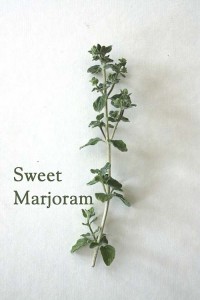There are plenty of names for shades of blue: azure, cerulean, indigo, cobalt, ultramarine, sky, and navy. And then there’s even the special synthetic intense ultramarine shade that artist Yves Klein patented under the name “International Klein blue.”
A visit to a nursery, however, seems to come up with only a short list of plants having flowers that are truly, intensely blue. Among the more common plants pansies, delphiniums, periwinkles and cornflowers would qualify. But decades of breeding attempts with roses and phalaenopsis and cattleya orchids have failed to produced anything other than pale mauvey or lavenderey colors, mainly because those plants don’t produce the necessary blue pigments in the first place.
There are laboratory subjects that have been genetically modified to carry the genes to produce blue pigment, and they’re producing flowers that are knocking on the door of being blue. For a flower to be blue, however, in addition to having the right pigments, the pH of the petals has to be absolutely correct. Otherwise you get pinks or more of those close-but-no-cigar colors like lilac. (If you’ve played with altering the color of hydrangea blossoms or making litmus paper change from pink to blue you’re already familiar with the controlling effects of acidity. Of course the big difference is that you can accomplish hydrangea color change without going into the lab.) The basic genetic modification process creeps me out a bit, and genetically-modified carnations are sensibly banned from Europe.
Fortunately the sage genus, Salvia, contains a number of species with flowers that require no genetic manipulation to achieve their amazingly blue colors. I’ve devoted a corner of my garden to three of them: ivy-leafed sage, arrow-leafed sage, and gentian sage.
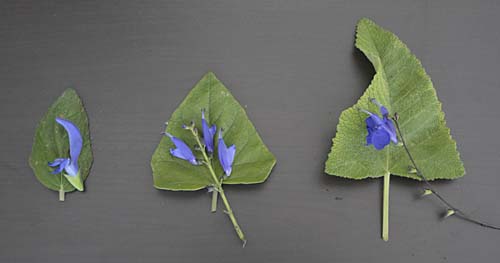
The three species compared, left to right: Salvia patens ‘Oceano Blue,’ S. cacaliaefolia, and S. sagittata.
The ivy-leafed sage, Salvia cacaliaefolia, is a robust grower, four to five feet tall and as big around as you’ll let it get. I’m starting to call it the “walking sage” because it can set down roots where the fairly lax stems touch the ground. It also sends up new stems from runners, though these don’t wander too far from the plant. Rambunctious, yes, but the plant has been easily controlled with the help of Mister Pruning Shears.
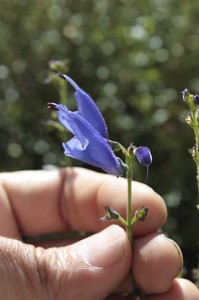
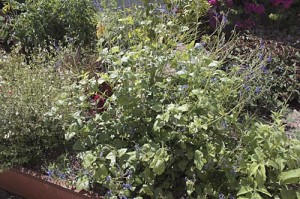
As its common name would suggest the leaves are a little ivy-like, triangular, three inches in length, and a pleasant medium green color. The spaces between the paired leaves can approach eight or nine inches, making the plant look a little stemmy and informal, but I find the mounding plant to be graceful and attractive.
Before the flowers open the buds develop an intense, almost indigo-blue shade, about as close to International Klein Blue as you’ll find in the garden. The buds open to clean blue flowers, fairly simple tubular affairs that are about and inch and a quarter long. What the flowers might lack in size and showy complexity they make up with their sheer profusion. The plant went into the ground November 18 of last year, and it’s never been without flowers except for when the sprinkler or heavy rains knocked them off. Hardiness reported to Zone 9.
The arrow-leafed sage, Salvia sagittata, grows smaller than the previous species. So far, for me, the plant is maybe two feet tall and three wide, with the inflorescence adding a foot to the height. True to name, the leaves are shaped like an arrowhead. They easily attain six inches in length, and have an attractive light, almost lime-green coloration. Towards the end of the season the plant can lose its lower leaves and get leggy, so you might want to plant something small and mounding near the plant to disguise the stems. (I’ve planted some lime thyme.)
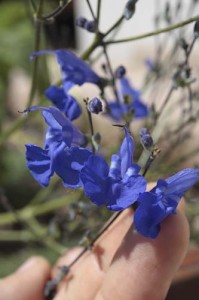
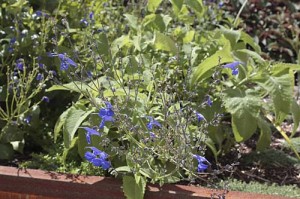
The flowers are about the same size as those of the ivy-leaved sage, and take the form of small tubes with one petal modified to form a frilly little “skirt”–a handy platform for insects to land on. (If this were an orchid, the flower part would be called the labellum, the “lip.”) The blooms float on thin, dark stems that make them look like exotic little butterflies hovering over the plant. Their color is a vivid medium blue color, a main-line blue so pure it doesn’t need a fancy name. Peak bloom runs from May to late fall in San Diego. Considered a tender perennial, probably hardy into Zone 9.
The gentian sage, Salvia patens, is the newest addition to my garden. The clone I chose is ‘Oceano Blue.’ So far the plant is about 30 inches tall and 15 wide, definitely the most constrained of these three species. Leaves are oval-to-pointed (“ovate”), medium-dark green, and about two inches long.
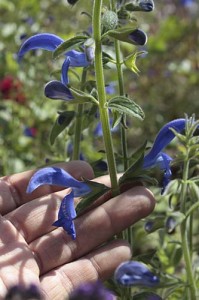

The flowers are almost identical to arrow-leaved sage in color–an intense medium blue–but the flowers are huge by contrast, exceeding two inches in length and height. The petals have a distinct formation that makes me think of a crab claw. I haven’t grown it through the warmest months, but it has a reputation for slowing down in its floriferousness, something I’m beginning to observe. Hardiness reported to Zone 8.
And what about the common bedding plant Salvia farinacea ‘Victoria Blue,’ the mealy cup sage? It can be a great plant, particularly in warmer, less humid climates and seasons when powdery mildew isn’t an issue. The flowers, however, range more towards blue-violet, not a pure shade of blue. So if you’re a blue purist, fuggedaboutit.
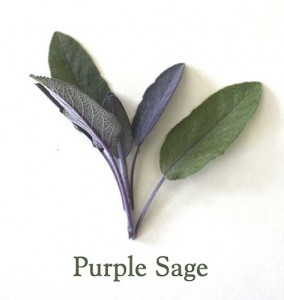 Sage (Salvia officianalis): European Garden sage comes in lots of versions in leaf color (green, golden, tri-color or purple) and flavor (“sage” flavor, pineapple, or grape).
Sage (Salvia officianalis): European Garden sage comes in lots of versions in leaf color (green, golden, tri-color or purple) and flavor (“sage” flavor, pineapple, or grape).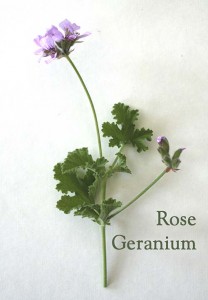 Scented geraniums (Pelargonium spp.): Take your pick of rose, apple, cinnamon, nutmeg, pineapple, lemon, lime, apricot and others.
Scented geraniums (Pelargonium spp.): Take your pick of rose, apple, cinnamon, nutmeg, pineapple, lemon, lime, apricot and others.

